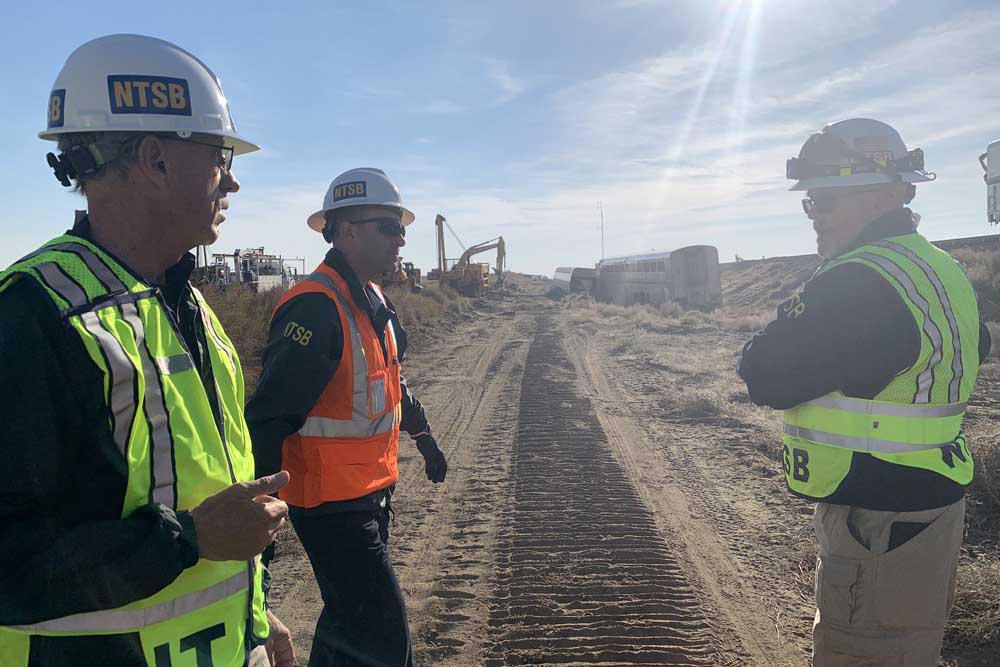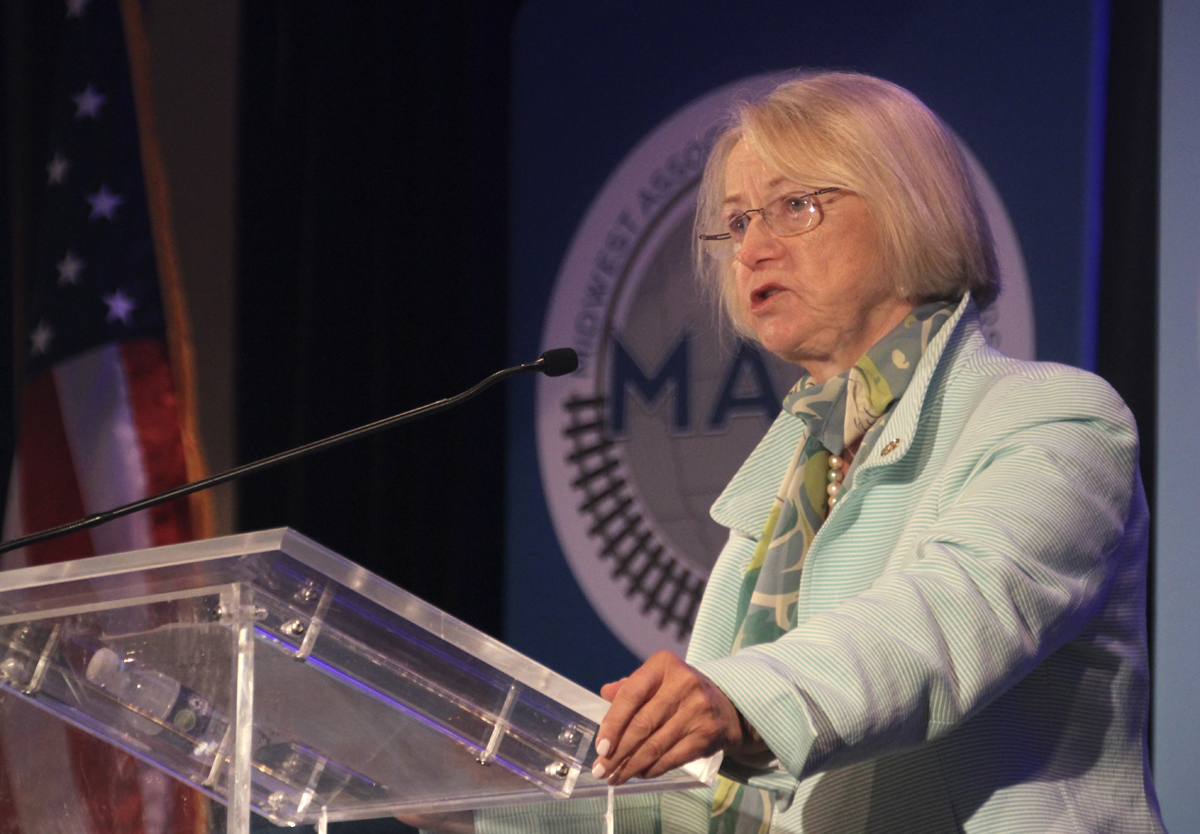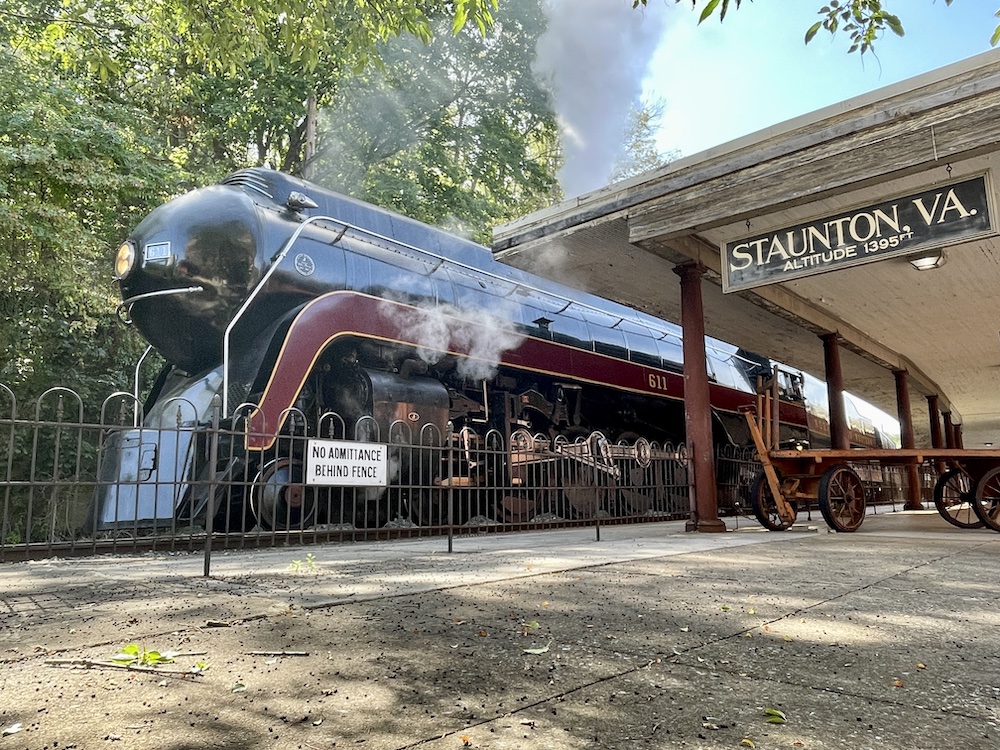
JOPLIN, Mont. — The vice chair of the National Transportation Safety Board says Amtrak’s Empire Builder was traveling below its posted speed limit when it derailed and partially overturned over the weekend in rural Montana, killing three people.
NTSB Vice Chairman Bruce Landsberg told members of the media Monday afternoon that the eastbound Empire Builder was traveling at between 75 and 78 mph when it derailed along BNSF Railway’s Hi Line Subdivision on Saturday. Landsberg says the posted speed limit for passenger trains on the line is 79 mph and that the track is inspected regularly by its owner, BNSF Railway. “The derailment occurred on a gradual right-hand curve, and it occurred prior to reaching the switch that is there for a siding,” Landsberg told reporters. “There was a track inspection conducted on the 23rd by BNSF and they advised us they are conducting approximately two track inspections every week on this section of track.” Landsberg says the maintenance of the rail line will be a focus of investigators in the derailment probe.
“Maintenance is going to be a very big concern for us,” Landsberg says. “We don’t know at this point exactly what happened, whether it was a track issue or whether it was a mechanical issue with the train, so all these things are open.”
Monday’s media briefing offers the latest update on the derailment investigation since NTSB officials arrived at the scene on Sunday. Landsberg says the investigation into the derailment, which claimed the lives of three people and resulted in injuries to approximately 50 more people, will likely take months to complete, but a preliminary report will be published in about 30 days. He says the investigation will be a sweeping probe and will include interviews with crew members of the Empire Builder, as well as other trains which traveled the same rail line on Saturday, and also maintenance workers and others.
Landsberg says a BNSF freight train passed through the area about 80 minutes prior to the Empire Builder’s derailment, which occurred at approximately 3:55 p.m. Saturday. He says federal investigators are conducting frame-by-frame reviews of forward-facing camera footage from that freight train’s locomotive, as well as from the lead locomotive, Amtrak No. 74, which was allowed to be moved from the derailment scene along with its trailing locomotive and some cars on Monday.
“We are not ruling anything out at this point. We have ruled everything in,” Landsberg says. “This is our first day on the ground and the team for the on-scene portion will be here for probably the better part of the week, so there is a lot of work to be done yet.”
While offering few details on the circumstances of the crash, one grim factor the NTSB is investigating, Landsbergs says, is the possibility that passengers may have been ejected from the train during the wreck. In response to a question from a reporter, Landsberg said there is no evidence of such an occurrence at this time, but it is possible. “This is something that the NTSB has looked at in prior crashes, so it’s definitely going to be a point of interest,” Landsberg says.
Saturday’s crash occurred near the unincorporated community of Joplin in north-central Montana, just about 30 miles south of the Canadian border. The train consisted of two locomotives and 10 cars, eight of which derailed with four of the cars overturning. The overturned cars, which include a Sightseer Lounge, two coaches and a sleeper, were on the rear of the train and are part of Empire Builder’s Portland section. The Associated Press is reporting that emergency responders attempted unsuccessfully to cut through the roof of at least one of the overturned cars to evacuate passengers from the wreck who were unable to walk. The evacuation of passengers lasted for about three hours after the derailment.
Another NTSB investigator at Monday’s briefing said the derailment scene is scattered for several hundred yards. Landsberg added that, “The train was moving at 75 to 78 mph and they don’t stop on a dime, even when they come off the tracks, so it’s pretty well spread out.” Landsberg also says that the preliminary report on the derailment will shed light on “what” happened in the derailment, but it will likely take longer into the investigation to determine “why” the derailment occurred.
Landsberg did not indicate when officials would hold another media briefing.














I’m a train rider. Flew a lot too. Stopped flying when me, 6foot 7inch senior citizen, started having back issues and major surgery. There is just simply not enough leg room between airline seats, exception the emergency exit seats. Therefore, the train fits my needs better. Of course, being retired, I have all the time in the world too. As for this accident, I am saddened, and my condolence to the families. That being said, I believe that on an average weekend, the nation sees about 300 automobile deaths. And we still have no fears about driving.
Exactly.
Given the fortune the RR’s spent on PTC, was it really news that the train was within the speed limit?
My personal experience of being involved in derailments like this: they were caused by a broken rail.
But every derailment is unique, so there are many other factors.
Seeing the heading about the train being under the speed limit I expected to see it dramatically under the authorized speed of 79 mph. What with all the experts on site I wonder what the speed really was 76 or 77 mph since it was between 75 and 78. Really not much under the authorized speed limit and really not a reason or cause of the derailment.
On any given highway almost every driver is 7 mph over the speed limit. Which has nothing to do with the highway crashes that do occur. In contrast if a railroad crew gets into a crash, 7 over is held against them big time.
True statement, Charles. Many years ago, there was a semi/Amtrak collision which resulted in a derailment with multiple deaths and injuries. The NTSB report cited the train speed (82 – 3 mph overspeed) at the time of the accident as a causal factor. However, the truck average speed from his last stop to the time of the accident (5 mph above the speed limit) was only mentioned as a contributing factor.
I worked in engine service between Boston and New Haven on the north end of the NEC prior to electrification. Although we had cab signals which limited our speed beyond restrictive signals and could have exceeded 79 mph we were limited to 79. We as a matter of course ran not to exceed 10 over or to 89 mph with never a problem. In my 17 years I never was a part of or witnessed an injury; and we often changed power in New Haven in as little as 8 minutes. The so called safety culture may have some points but it does seem to be an example of over kill. Much of it only results in needless delay. It strikes me as “cover your backside” mentality. It isn’t necessary. Even if #7 was traveling at 85 to 90 it probably would have made little difference. Things like this are the explanation for my having left the industry.
I worked in engine service between Boston and New Haven on the north end of the NEC prior to electrification. Although we had cab signals which limited our speed beyond restrictive signals and could have exceeded 79 mph we were limited to 79. We as a matter of course ran not to exceed 10 over or to 89 mph with never a problem. In my 17 years I never was a part of or witnessed an injury; and we often changed power in New Haven in as little as 8 minutes. The so called safety culture may have some points but it does seem to be an example of over kill. Much of it only results in needless delay. It strikes me as “cover your backside” mentality. It isn’t necessary. Even if #7 was traveling at 85 to 90 it probably would have made little difference. Things like this are the explanation for my having left the industry.f
Did you watch the press conference? He stated the recorded speed was between 75 and 78 and, without reviewing it, I think he said depending on the location. It’s possible that preliminarily, they are establishing a section of track to be within the investigation and it’s possible the event recorder ticked up or down 3 mph from the beginning to the end. So, for example, there could be 2000 feet of track in the confines of their investigation and the train slowed or sped up 3 mph from the start to the point of derailment, which might be when it went into emergency.
Historically speaking, when the railroads ran the passenger trains they set their speed at 90 MPH on open stretches of track.
Amtrak is just a shadow of what train travel was.
It’s always interesting to read how the anti long distance Amtrak folks on this site always qualify themselves by stating how they “love to ride passenger trains”.
Possibly true Chris – and there’s no contradiction between the two contentions. I have ridden them and I have loved them.
By the way I’m not necessarily against the LDs. Run them 2x daily with added connectivity, we’d have something to talk about! One train pair into Atlanta or St. Paul or Denver is ridiculous … and uneconomic.
I love to ride Amtrak. I don’t like the fact that as a nation we pay so much for it.
Actually 6 cars since the diner & lounge are not permanent seating plus the sleepers accommodate fewer passengers so it is fairly typical of this time of year in this segment of the route. As for an earlier comment about Amtrak serving only the NEC this region has few mobility options while the NEC residents have bountiful choices at their disposal if anybody could afford to loose an travel option it the NE.
There were 141 passengers on the train at the time of the derailment. What is the total passenger count for the whole trip from CHI to SEA. The two times I rode the train there were numerous passengers only riding part of the way and not just to or from the endpoints.
141 passengers on an 8 car high-level train. That’s less than 20 people per car. This is economic?
141 passengers on an 8-car transcon may not be economic but it’s typical (or maybe way better than typical) for the central segment. The western LD’s carry a heavier load closer to the metropolitan end-points, not the middle of Montana.
Comparing accident and passenger fatality statistics by mode, it is clear that air travel rates as safest. However, LD passenger rail is not far behind. In both modes, any significant accident skews the data because of the rarity of such occurrences. The worst mode, by double digit multiples, is highway travel. As a manner of travel, who among us would prefer a two day trip on a bus vs. rail? I’ll take the train.
“As a manner of travel, who among us would prefer a two day trip on a bus vs. rail?”
How about three hours by plane? And equal or less cost?
I like Amtrak, too, but as a nation we should be realistic about the cost/benefits. Amtrak for long-distance travel wasn’t economically viable in 1971 and it still isn’t today.
Hello Matt. I hope that you are doing well. I still prefer the train. And our subsidy of passenger rail is far less than our subsidy of the highway system. Air travel is also subsidized. No airport makes money for investors.
Many foreign airports are privately owned and their shares are held by private investors for future gains (based on past results).
Everybody “subsidizes” the roads but everybody also directly benefits from them. We pretty much all drive and/or buy products which are carried by truck at least part of the way. A reasonably large percentage fly. Very few of us ride passenger trains on the LD network. One subsidy is from the many back to the many; the other, the many to the few. What is the govt’s cost per passenger mile of each mode?
And yes, multiple days on a bus is torture (done that) while multiple days on a train is a pleasure.
Several good points above. Seems I’m not the only Peter O’Toole think – alike on this forum. Patrick Evans (above) and me, that makes two. I love to travel by train – I have ridden every sort of train in four countries and enjoyed almost all of it. Here in USA or in Canada, rail is no longer practical for anything over about 250 miles – and even in those cases only on routes with multiple daily frequencies.
The next time I want to travel from Columbus to Nashville, or Las Vegas to Austin, I don’t think I’ll dial up Amtrak. Even on doable rail routes like Milwaukee to Detroit, I now find that the airlines fit my needs better.
Yesterday I got roundly criticized for suggesting that airlines seem to be safer than Amtrak. Does anyone really disagree? USAirways crash-landed into the Hudson River with no deaths and no serious injuries.
You guys mean Randal O’Toole don’t you? Peter O’Toole was an actor of stage and film.
Yes : )
Yes 🙂
But then there were the two Boeing 737-Max crashes that killed everyone on board. Not all air crashes are survivable.
Maybe there should be no Amtrak outside the NEC, and possibly Auto Train. It has a sliver of passenger miles (vs. air, motor coach, and automobile). Let those who own the tracks decide if passengers are a worthwhile market—if the economics have changed since 1971, they will provide the service. Otherwise, the other modes could absorb Amtrak’s share at little marginal cost. Megabus has ENTERED the market in recent years, so it can be done. Brightline might succeed.
Privatize the NEC.
I would personally ride a train and seek it out, but it rarely is practical. The Cardinal worked to get to DCA if my travel matched the thrice-weekly schedule, which was rare, and it could be hours late!!! It was not feasible outbound despite the very good Metro connection to DCA from Union Station. Driving was the better option due to reliability—NOVA traffic is more predictable than Amtrak’s on-time performance.
I hope they find and fix the root cause of the wreck. God help the victims.
Amtrak is sadly reliving its early days—nothing but bad press. They ought to restore an SDP40F so BNSF can tell them to get off their rails for good.
Sorry, my Peter O’Toole is showing. I really do prefer to ride the train.
Hilarious.
Train was westbound, not eastbound as stated in this article.